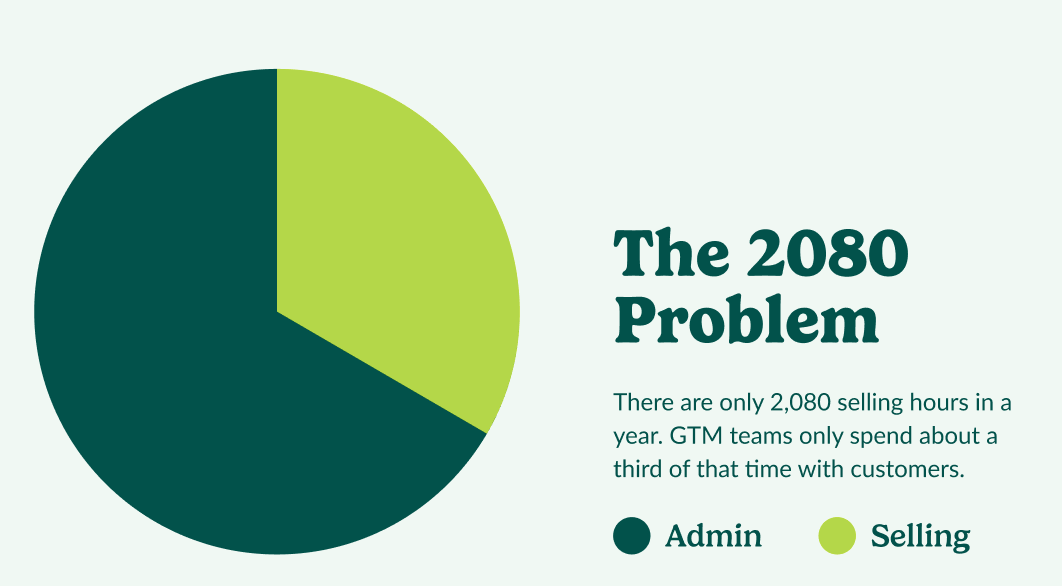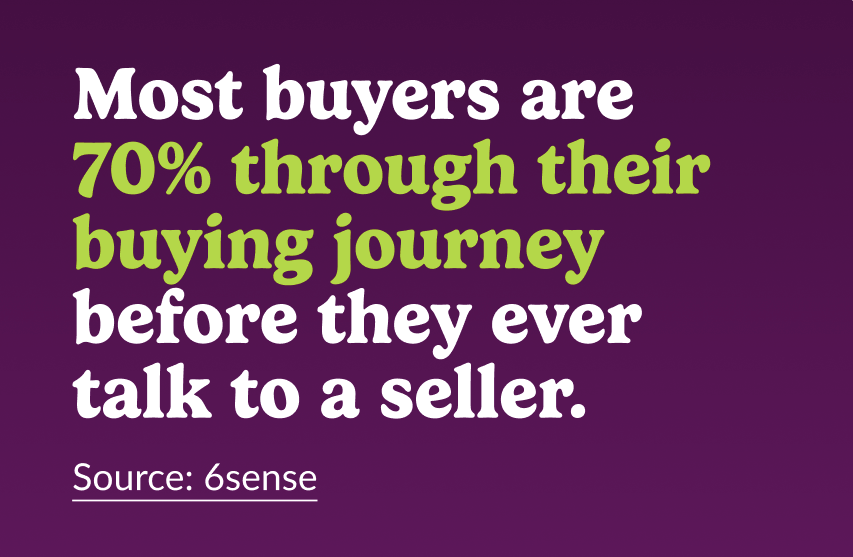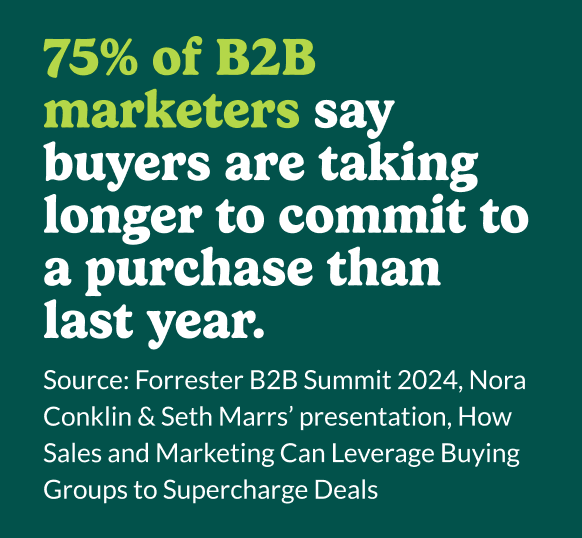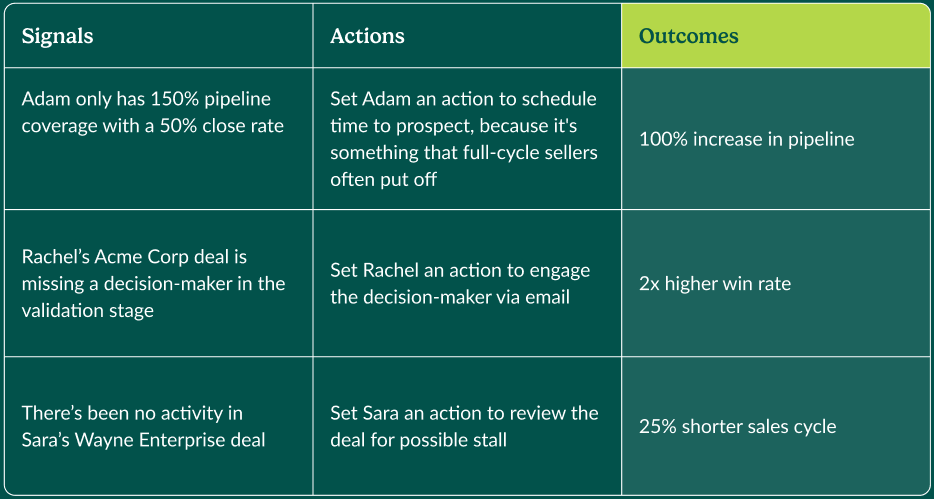The 2080 Problem: Your Most Overlooked Enterprise Revenue Blindspot
Published:

Selling time is slipping away
Each of your sales reps has 2,080 hours a year to sell. That sounds like more than enough time to hit their numbers and drive toward your growth target, but it’s not.
Once you remove time spent updating CRMs, attending forecasting meetings, searching sales enablement content, and a dozen other activities, reps have even less time. Their 2,080 hours shrink to just 690 — or 13 hours active selling hours per week. Thirteen hours to get in front of buyers, win their trust, and land deals. It’s not enough.

But focusing on just time misses the point.
Reps aren’t struggling for time because they’re doing something wrong. It’s because the underlying system is broken. Most sales motions operate on disjointed tech stacks and inefficient, manual processes. And the worst part is that those systems don’t even work.
Buyer experience is cratering. Reps are burning out. Opportunities are falling through the cracks. It all adds up to missed targets and slower revenue growth. The consequences are real and modern sales demands a new approach.
This guide calls on decades of experience and insights from across Salesloft to show you how to reclaim your sellers’ time, rationalize your technology, and equip sellers with tools that alleviate, rather than create, busy work.
Want to skip ahead and find out how much "The 2080 Problem" is costing your revenue org? Check out this handy calculator to see how your revenue potential is being impacted.
The state of sales: Tech as a speed bump or accelerator?
While technology can certainly help address The 2080 Problem, it’s not a silver bullet.
Years of technology bloat have left reps buried under a mountain of “point solution” tools, each one designed and built to solve a specific problem. Think dialers, screen recorders, schedulers, contract platforms, demo tools, commission trackers, and dozens more.
Each tool produces helpful data, but it’s locked away in each piece of software, making it hard to contextualize, synthesize, and act on. Reps have to jump from tool to tool and task to task, fragmenting their attention and creating hours of admin work. When reps’ tech creates busy work, it’s no surprise they’re burning out.
Reps know that face-time with buyers is crucial, but they’re stuck updating their CRM, submitting forecasts, and validating data.
Even the best reps can’t check every single tool at once. They’re inevitably missing signals like a decision maker reading (but not signing) a contract or a CIO asking for advice from their peers on LinkedIn. Without that context, sellers can’t take smart actions to drive deals forward.
Your CRM alone can’t solve these issues
Faced with data gaps, it’s tempting to double down on CRMs and yet more manual data entry. That’s a mistake. While CRMs are incredibly important, they were never designed to support selling workflows. They’re a window into a database, not a platform for action.
The challenge isn’t unique to sales. Sales and marketing should be an organizational power couple, but more often than not, they’re chronically unaligned. Most buyers are 70% through their buying journey before they ever talk to a seller. They’ve done their research, built a shortlist, and evaluated their options. Each engagement on a buyer’s journey should feel like the natural extension of the one that came before. But so often, it doesn’t. Marketing data doesn’t flow to sales, context gets lost, and handoffs feel clunky.

Buying committees are expanding
To amplify the challenge, buying committees are bigger than ever. Nearly two-thirds of tech deals now involve between four and 10 people.
Ballooning buying committees mean that everyone’s a buyer now — project managers, lawyers, IT, finance, operations, the list goes on. The growth in buying committees suggests a mindset switch on the buyer’s side — from simple procurement to complex problem-solving.
Reps have to maintain relationships with every single buyer, creating dozens, if not hundreds, of new connections. Each buyer’s on their own journey, too, turning deals into a mess of synchronous research, exploration, comparison, and selection. It’s impossible for reps to get full visibility on every buyer. Missed signals and actions inevitably push deals to the right.
Everything adds up to missed opportunities and lower revenue.
If a rep is working 12 enterprise deals, that’s more than a hundred individual relationships they have to manage and document. Reps are freaking out.
The need for sales artistry paired with AI
Forrester’s September 2023 Artificial Intelligence Pulse Survey found that 70% of enterprise-level companies are already using genAI and another 20% are exploring its use.
While many leaders, including revenue leaders, are bullish about AI, they’re still looking to strike the delicate balance of using AI to boost productivity while maintaining meaningful relationships between sellers and buyers.
Of course, in a field as intensely human as sales, you have to tread carefully. You hire sales reps because they connect with buyers in a way that a piece of software simply can’t.
Reps can think creatively, act strategically, and negotiate personally. Those are the things that humans do best. But as you’ve seen, most of your reps’ time is spent on other work: manual data entry, tedious reporting, and unnecessary meetings. That’s where AI can step in, shoulder the burden, and leave reps free to focus on what they do best — selling.
When you talk about AI, you have to ask three questions: What can you automate? What's uniquely human? And how can you augment that human value?
Making every minute matter: Meeting buyers where they are
Modern buyers look and act nothing like their counterparts in the early 2000s or 2010s. They don’t follow flowcharts and while they do still tick off traditional buying journey steps like problem identification and supplier selection, they do so more or less simultaneously.
The buyer journey is growing more complex and the people buying are getting more risk-averse.

From gatekeepers to consultants
Buyers have completed the bulk of their research before they ever contact a sales rep. More than 80% of deals are won or lost before a rep even knows they exist. Moreover, they devote just 17% of their time to meeting with potential vendors — that’s all vendors, not just you. Your allotment is a measly 5 or 6%.
So when sellers actually get to meet with buyers, sellers better make that interaction count by delivering the specific information buyers are after. What buyers are looking for isn’t a pushy seller; it’s a partner, someone to help them understand the market landscape. They need someone to analyze all the different ways to address their problem.
The best sales reps develop their business cases with the buyer, use their words, and factor in the process the buying team uses when making their decision.
Once sellers communicate the context, then they can evaluate competing approaches and prove why your solution is better. It’s simple in theory, but complex in practice.
A stake in success (or failure)
Not only do sales leaders need to reorient why they’re engaging with buyers, but they need to rethink how they’re engaging, too. Modern buyers are in control, but they also have a personal stake in the success or failure of a purchase. And since the buying process is moving from traditional, top-down decision making to a group consensus gathering activity, more people will feel pressure to make the “right decision.” Your sales teams will need to work around multiple buyer preferences, schedules, and perspectives to close the deal.
Prove enduring value
In the days of zero interest rate policy (ZIRP), the solution was simple: throw money and people at the problem. But the economic calculus has changed. Growth at all costs is gone. Sustainable growth and profitability are the only ways forward. Not only are buyers looking for solutions that drive substantial growth, they don’t want to rethink the decision they made about a solution in a year or two. Their new technology or service should innovate faster than they are so they can use it long term.
Getting on the road to solving the 2080 Problem
Enough negativity.
The challenges facing sales organizations are indeed large, but they’re far from insurmountable. Enterprises have always looked for new ways to eke more value from their people, processes, and technology. One of the ways they’re finding success is replacing underperforming systems of loosely connected technology with a coherent and unified sales platform.
Here’s how it works.
Technology that simplifies your work
The best sales tech complements sellers’ humanity. And yet, as we’ve already discussed, sales teams have endured a decade of fractured and fragmented tools.
Disjointed systems require manual work because each tool wasn’t designed to work with the rest. When you have a unified platform, data flows from one capability to the next. You can use AI to automate the tedious and repetitive tasks that once devoured hours of your reps’ days, freeing them to invest their time in the most human parts of the sales process.
Moving from a mess of unconnected products to an interconnected platform that harnesses AI to support sellers is transformative. Your reps and managers can work from a single pane of glass — prospecting, forecasting, researching, coaching, learning, and closing. Everything is easy and in one place.
You can’t be successful without admin work. But there's an opportunity to automate it and give sellers hours back to spend with their buyers.
Build your sales decisions around buyer experience
Modern sales is strategic and consultative. Buyers want sellers to help them discover the best solution. The problem is, with ever-larger buying groups, it’s nearly impossible to keep tabs on what every individual wants out of a deal. Nearly impossible, but achievable with an interconnected platform.
Mature revenue platforms gather and interpret signals encompassing digital marketing and interpersonal sales, bridging the gap between online behavior and personal interactions.
But not all signals are created equally and it’s easy for buyer information to grow disorderly. Turning signals into action is where a platform comes into its own. Platforms ingest everything, work out what signals are important, and give your reps the perfect next step for every single buyer.
Those insights are gold for sales, marketing, and success. With a better understanding of your buying group, your teams can take connected action as one go-to-market org, joining up the entire buying journey from awareness to consideration and decision.
Insights that drive outcomes
Reps already have more data than they’ve ever had — buyer intent, demographic, behavioral, and so on. But so often, they’re missing the, “So what?” Too many organizations create data and then leave sellers to work out the rest. Reps need insights and actions, not just data.
You’re drowning in charts, graphs, and data tables. Instead of lighting the way to success, they’re leaving you in the dark. What you need are real insights.
Platforms unify your data, turning a mess of siloed observations into a coherent data set. With that full picture, you can equip your reps with the right context and suggest the right action in the moment to move deals forward.

Real insights are person and use case specific. What works for a pharmaceutical sales company won’t work for a software startup. Insights are actionable, too. To paraphrase management theorist Chris Argyris, if you can’t act on information, it’s barely worth having. Real insights not only get you to the how, but they tie the how to the why. They give you direct line of sight to outcomes like higher win rates, sales cycle acceleration, and pipeline growth.
Could reps have made the jump between data, action, and outcome themselves? Superstar sellers probably could have, but new reps and middle-of-the-pack performers? Not without a lot of effort. And with the growing complexity of deals and increase in noise, even superstar sellers might struggle. Platforms crunch your data, identify the best actions, and turn all your reps into superstars. They give you visibility into what works and make it easy to replicate winning actions time and time again.
Revenue Orchestration Platform: Your powerful sales engine
The 2080 Problem presents an existential challenge for sales organizations and businesses. If you ignore it and stick to outdated tactics, the road ahead looks short and bleak. But if you embrace technological, cultural, and procedural change, you can win back your reps’ time and unleash their productivity.
The future of sales lies in interconnected platforms that consolidate data, make sense of insights, and deliver a premium buyer experience. This new technology, called a Revenue Orchestration Platform, is a central engine for revenue generation.
According to Forrester analysts Anthony McPartlin and Seth Marrs, “[Revenue Orchestration Platforms] enable B2B organizations to orchestrate and maximize commercial performance from their revenue motions, including new logo acquisition as well as renewal and expansion motions for existing customer relationships.”
By bringing together conversational AI chat, sales engagement, deal management, conversation intelligence, sales coaching, and forecasting into one platform, you can deliver a step change in more consistent, repeatable performance.
Insights must be derived from signals generated from both buyers and sellers, rooted in action, and tied to outcomes. These factors form an infinite loop. Signals and insights lead to actions that create tangible outcomes for the business. Those outcomes then generate more insights, combine with additional signals, and the cycle continues. Revenue Orchestration Platforms should provide this set of capabilities – a flywheel across both the buyer and seller journey – bringing the combined intelligence into one orchestrated set of actions and outcomes.
Revenue orchestration platforms are not just another addition to the enterprise technology repertoire. They are a mandate for solving the 2080 Problem and reimagining the potential of your revenue organization.
The 2080 Problem undermines every single revenue team, stealing their time and limiting their impact. Salesloft helps revenue teams fight back. It can demystify data and identify the right actions to close every deal with the only platform built around the sellers’ workflow. The Salesloft Revenue Orchestration Platform aligns revenue teams so they can prioritize and execute all their actions to improve buyer and customer engagement throughout the entire buyer journey, driving improved productivity, and better pipeline efficiency and revenue outcomes.
Thousands of the world’s top revenue teams, like those at Google, 3M, IBM, Shopify, Square, and Cisco, drive more revenue with Salesloft.
For information on how we’re combating the 2080 Problem and more, request a demo.


























